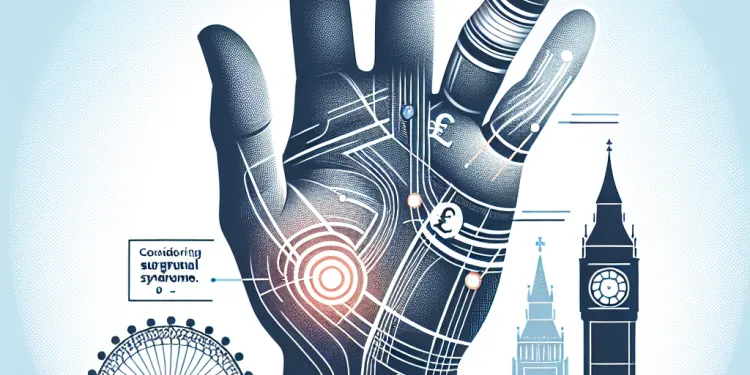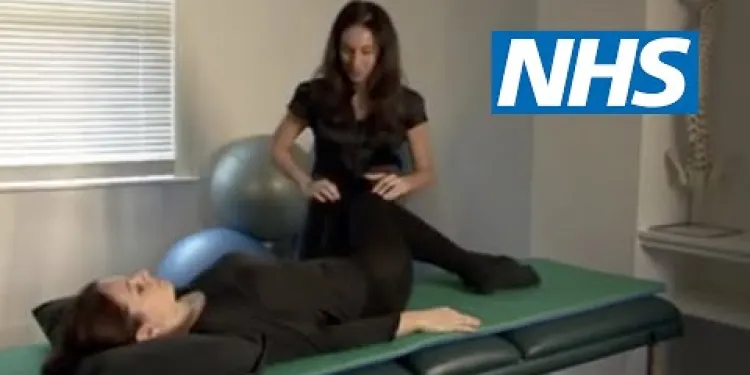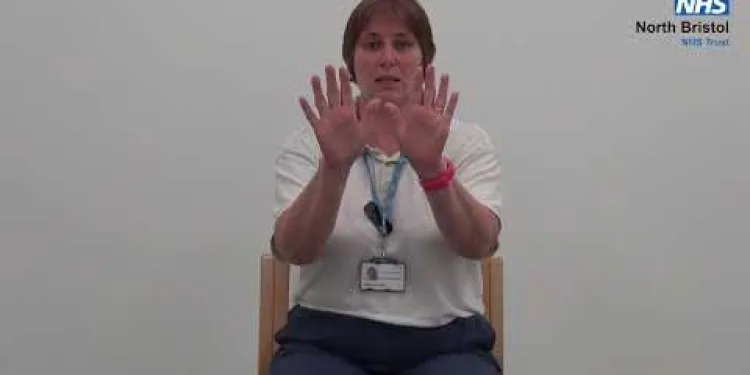
Find Help
More Items From Ergsy search
-

Carpal Tunnel Syndrome
Relevance: 100%
-

Are there specific exercises that can help with Carpal Tunnel Syndrome?
Relevance: 99%
-

What causes Carpal Tunnel Syndrome?
Relevance: 93%
-

Is Carpal Tunnel Syndrome covered by the NHS?
Relevance: 92%
-

What is Carpal Tunnel Syndrome (CTS)?
Relevance: 91%
-

How can I prevent Carpal Tunnel Syndrome?
Relevance: 91%
-

How is Carpal Tunnel Syndrome diagnosed?
Relevance: 89%
-

Can Carpal Tunnel Syndrome recur after treatment?
Relevance: 86%
-

Are there any alternative treatments for Carpal Tunnel Syndrome?
Relevance: 86%
-

What non-surgical treatments are available for Carpal Tunnel Syndrome?
Relevance: 85%
-

When should I consider surgery for Carpal Tunnel Syndrome?
Relevance: 85%
-

What does Carpal Tunnel Syndrome surgery involve?
Relevance: 85%
-

Can lifestyle changes help manage Carpal Tunnel Syndrome?
Relevance: 79%
-

Can I work or continue sports activities if I have Carpal Tunnel Syndrome?
Relevance: 78%
-

What are the common symptoms of Carpal Tunnel Syndrome?
Relevance: 75%
-

What is the recovery time after Carpal Tunnel Surgery?
Relevance: 66%
-

Exercises for sciatica: piriformis syndrome | NHS
Relevance: 40%
-

Is chronic fatigue syndrome contagious?
Relevance: 27%
-

Prader-Willi Syndrome | NHS
Relevance: 26%
-

What is chronic fatigue syndrome?
Relevance: 25%
-

What is Cushing's syndrome?
Relevance: 25%
-

Greater trochanteric pain syndrome
Relevance: 25%
-

Munchausen's syndrome | NHS
Relevance: 24%
-

Is chronic fatigue syndrome a mental illness?
Relevance: 24%
-

Turner syndrome: Beyond the classic XO phenotype
Relevance: 23%
-

What is irritable bowel syndrome (IBS)?
Relevance: 23%
-

Does physical exercise help people with CFS?
Relevance: 23%
-

About irritable bowel syndrome (IBS)
Relevance: 23%
-

About irritable bowel syndrome (IBS)
Relevance: 23%
-

Having a child with Down's syndrome | NHS
Relevance: 23%
-

How is chronic fatigue syndrome treated?
Relevance: 23%
-

Down's syndrome: Emily's story | NHS
Relevance: 22%
-

Treating irritable bowel syndrome (IBS)
Relevance: 22%
-

Charles Bonnet Syndrome
Relevance: 22%
-

Can children develop chronic fatigue syndrome?
Relevance: 22%
-

Neck Exercises
Relevance: 22%
-

Neck Exercises
Relevance: 22%
-

What causes chronic fatigue syndrome?
Relevance: 22%
-

Shoulder Exercises 1
Relevance: 22%
-

What is complex sleep apnea syndrome?
Relevance: 22%
Understanding Carpal Tunnel Syndrome
Carpal Tunnel Syndrome (CTS) is a condition that affects the hand and wrist, characterised by pain, tingling, and numbness. It occurs when the median nerve, which runs from the forearm into the palm, becomes compressed in the carpal tunnel, a narrow passageway on the palm side of your wrist. CTS can be caused by a variety of factors, including repetitive hand movements, wrist anatomy, or health conditions such as diabetes or rheumatoid arthritis.
How Can Exercises Help?
While more severe cases of carpal tunnel syndrome may require medical intervention, mild to moderate symptoms can often be managed with specific exercises. These exercises aim to reduce swelling, improve flexibility, and enhance circulation in the affected area, thereby alleviating symptoms. Performing these exercises regularly can help reduce pressure on the median nerve and improve overall hand function.
Recommended Exercises for Carpal Tunnel Syndrome
Wrist Flexor Stretch
Start by extending your arm in front of you with your palm facing upwards. Use your other hand to gently pull your fingers back towards your body until you feel a stretch in your forearm. Hold the stretch for 15-30 seconds, and repeat three times on each wrist. This exercise helps to relieve tension in the wrist flexor muscles.
Wrist Extensor Stretch
With your arm extended in front of you, palm facing down, use your other hand to gently bend your wrist, bringing your fingers towards your body. Hold the position for 15-30 seconds, repeating three times per wrist. This stretch targets the muscles on the top part of the forearm.
Median Nerve Glide
Begin with your arm at your side and elbow bent at a right angle, fingers pointing upwards. Slowly straighten your elbow while extending your fingers and wrist. Continue until you feel a gentle stretch, then return to the starting position. Perform 5-10 repetitions on each arm. This exercise helps improve mobility and reduces pressure on the median nerve.
Wrist Circles
Gently rotate your wrists in circles, ten times in each direction. This simple movement increases circulation and helps maintain wrist flexibility. It is also an excellent warm-up exercise to perform before other stretches.
Conclusion
Incorporating these exercises into your daily routine can be beneficial for individuals experiencing the symptoms of carpal tunnel syndrome. However, it is crucial to consult with a healthcare professional before starting any exercise programme, especially if you have severe symptoms or other underlying health conditions. Early intervention and regular exercise can help manage symptoms effectively and improve quality of life.
What is Carpal Tunnel Syndrome?
Carpal Tunnel Syndrome (CTS) is when your hand and wrist hurt, feel tingly, or numb. This happens because a nerve in your wrist is squished. The nerve goes from your forearm to your hand. Things like doing the same hand movements over and over, or health problems like diabetes, can cause CTS.
How Can Exercises Help?
For some people, doing special exercises can help the pain and tingling in their hands. These exercises can make your hand and wrist feel better by reducing swelling and making your hand more flexible. They also help by making blood flow better, which can help your hand work well again.
Try These Exercises
Wrist Flexor Stretch
Hold your arm out straight in front of you with your palm up. Use your other hand to gently pull your fingers back toward you. You should feel a stretch in your arm. Hold it for 15-30 seconds. Do this three times on each wrist. This stretch helps make your wrist feel less tight.
Wrist Extensor Stretch
Put your arm out straight in front, but this time, with your palm facing down. Use your other hand to gently bend your wrist, bringing fingers toward you. Hold it for 15-30 seconds. Repeat this three times per wrist. This stretch helps the muscles on top of your arm.
Median Nerve Glide
Start with your arm by your side. Bend your elbow and point fingers up. Slowly straighten your elbow and straighten your fingers and wrist. Keep going until you feel a gentle stretch. Go back to the start position and do it 5-10 times on each arm. This exercise helps the nerve move better and feel less squished.
Wrist Circles
Gently move your wrists in circles, ten times each way. This helps blood flow and keeps your wrists flexible. It's also a good way to warm up before the other stretches.
Conclusion
Doing these exercises every day can help if your hands and wrists hurt from carpal tunnel syndrome. But, talk to a doctor before starting if your pain is severe or if you have other health issues. Regular exercises can help you feel better and improve your daily life.
Frequently Asked Questions
What is Carpal Tunnel Syndrome?
Carpal Tunnel Syndrome is a condition caused by pressure on the median nerve in the wrist, leading to symptoms like pain, numbness, and tingling in the hand and arm.
Can exercises help with Carpal Tunnel Syndrome?
Yes, specific exercises can help relieve symptoms and improve wrist and hand function by reducing pressure on the median nerve.
What type of exercises are beneficial for Carpal Tunnel Syndrome?
Exercises that involve stretching and strengthening the wrist, hand, and forearm muscles are beneficial. These include tendon gliding exercises and wrist flexor stretches.
How often should I do Carpal Tunnel exercises?
It is generally recommended to perform these exercises daily or as advised by a healthcare professional.
Are there any risks associated with Carpal Tunnel exercises?
When done correctly, these exercises are safe. However, performing exercises incorrectly or overdoing them may worsen symptoms, so it's important to follow instructions or consult a therapist.
Can Carpal Tunnel exercises prevent surgery?
In some cases, regular exercises can help manage symptoms and delay or prevent the need for surgery, but this depends on the severity of the condition.
What is a tendon gliding exercise?
Tendon gliding exercises help the tendons in the wrist move smoothly through the carpal tunnel. This involves moving fingers into different positions, such as straight, hooked, and fist.
What is a wrist flexor stretch?
A wrist flexor stretch involves extending the arm and gently pulling back on the fingers to stretch the muscles in the wrist and forearm.
Can I do Carpal Tunnel exercises at my desk?
Yes, many Carpal Tunnel exercises are simple and can be done while sitting at your desk or any other convenient location.
How long do Carpal Tunnel exercises take to show results?
While some people may feel relief quickly, it typically takes several weeks of consistent exercise to notice significant improvements.
Should I do Carpal Tunnel exercises if I feel pain?
If you experience pain during exercises, it's important to stop and consult a healthcare professional to ensure you're performing the exercises correctly and safely.
Do Carpal Tunnel exercises help with stiffness?
Yes, these exercises can help reduce stiffness in the wrist and improve overall mobility.
Are there any tools or equipment needed for Carpal Tunnel exercises?
Most Carpal Tunnel exercises rely on self-stretching and hand movements. Sometimes, tools like a stress ball or resistance band can be used to enhance the exercises.
Can yoga help with Carpal Tunnel Syndrome?
Yes, certain yoga poses that focus on stretching and strengthening the wrist and hand muscles may help alleviate Carpal Tunnel symptoms.
Can I combine Carpal Tunnel exercises with other treatments?
Yes, exercises can be combined with other treatments like wrist splints, ergonomic adjustments, and medications for more comprehensive management of Carpal Tunnel Syndrome.
How do I know if Carpal Tunnel exercises are working?
Improvement in symptoms, such as reduced numbness, pain, and increased strength and mobility, can indicate that exercises are beneficial.
Can physical therapy include Carpal Tunnel exercises?
Yes, physical therapists often include specific exercises in a treatment plan to help alleviate Carpal Tunnel symptoms.
Is it necessary to warm up before doing Carpal Tunnel exercises?
While not always necessary, warming up with gentle finger and wrist movements can enhance the effectiveness of the exercises.
Can repetitive motion cause Carpal Tunnel, and will exercises help?
Repetitive motions can contribute to Carpal Tunnel Syndrome. Targeted exercises can help mitigate these effects by strengthening and stretching the affected areas.
Should I consult a doctor before starting exercises for Carpal Tunnel?
It's a good idea to consult a healthcare professional to ensure that exercises are appropriate for your specific condition and to avoid any potential risk of harm.
What is Carpal Tunnel Syndrome?
Carpal Tunnel Syndrome is when your wrist hurts. It can also make your hand feel tingly or numb. This happens because a nerve in your wrist is squeezed. This nerve helps your hand move and feel things.
If your wrist hurts a lot, it is good to tell a doctor. They can help make it better. Sometimes, wearing a special wrist band can help protect your wrist. Doing exercises can also help make your wrist stronger.
Carpal Tunnel Syndrome happens when there is pressure on a nerve in your wrist. This can make your hand and arm feel pain, numb, or tingly.
Can exercises help with wrist pain?
Do you have wrist pain from Carpal Tunnel Syndrome?
It is a common problem. Your wrist might feel numb or tingly.
Doing special exercises can help. These exercises stretch and strengthen your hands and wrists.
You can also try these tips:
- Take breaks often if you use your hands a lot
- Keep your wrists straight
- Use a soft pad or cushion for your wrist
Remember to always ask a therapist or doctor for advice. They can show you the best exercises for your hands.
Yes, doing special exercises can help your wrists and hands feel better. These exercises can take pressure off a nerve in your wrist.
What exercises can help with Carpal Tunnel Syndrome?
If your wrist or hand hurts because of Carpal Tunnel Syndrome, you can try these easy exercises:
- Wrist bends: Bend your wrist up and down slowly. Do this five times.
- Finger stretches: Spread your fingers wide, then close them. Repeat five times.
- Hand shakes: Gently shake your hands like you are drying them.
These exercises are like gentle movements for your hands and wrists. They can stop the pain from getting worse.
You can also try using a soft ball to squeeze. This can make your hands stronger.
Remember, if your pain doesn't go away, it's important to talk to a doctor.
Doing exercises to stretch and make your wrist, hand, and forearm muscles stronger can help. Try moving your tendons with special exercises and stretching your wrist muscles.
How often should I do hand exercises?
Do hand exercises every day.
This will help your hands feel better.
Use a timer to remember when to do them.
Ask a friend or family member to help.
Try to do these exercises every day. You can also ask your doctor or nurse how often to do them.
Are Carpal Tunnel exercises safe?
These exercises are safe if you do them the right way. But if you do them wrong or do too much, it can make problems worse. It's a good idea to follow instructions or ask a therapist for help.
Can exercises stop Carpal Tunnel surgery?
Sometimes, doing special hand exercises can help with Carpal Tunnel. These exercises might make your hand feel better.
If your hand feels better, you might not need surgery. But it is important to talk to your doctor to know what is best.
Using tools like a wrist splint can also help. A splint keeps your hand in a good position.
Remember to do exercises and wear the splint as your doctor tells you.
Sometimes, doing exercises can help with symptoms. Exercises might also stop or delay the need for surgery. It depends on how bad the problem is.
What are tendon gliding exercises?
Tendon gliding exercises help your fingers move well. They keep the tendons in your hand healthy. Tendons are like ropes in your hand that help your fingers bend and straighten.
It's good to do these exercises when your doctor or therapist tells you to. They can help if your hand feels stiff or if you've hurt it.
You might see pictures or videos showing how to do these exercises. And using soft music or asking someone to count can make them more fun!
Tendon gliding exercises help your wrist move better. These exercises make the tendons, which are like stretchy bands, slide smoothly. You do this by moving your fingers in different ways, like straight, bent like a hook, and making a fist.
What is a wrist flexor stretch?
A wrist flexor stretch is a simple exercise. It helps your wrist feel better. You can do it to make your wrist muscles stretch.
Here is how you do it:
- Stand up or sit down.
- Hold one arm out straight in front of you. Your palm should face up.
- With your other hand, gently push your fingers down towards the ground.
- Hold this position for a few seconds.
- Switch hands and do it again.
Tools to help you:
- Ask a friend to show you how.
- Use a video to watch how it’s done.
To do a wrist flexor stretch, hold your arm out straight in front of you. Then, use your other hand to gently pull back on your fingers. This will help stretch the muscles in your wrist and forearm.
Can I do Carpal Tunnel exercises at my desk?
Yes, you can do Carpal Tunnel exercises at your desk. These exercises can help if your hands or wrists hurt from typing or using a computer.
Here are some simple steps:
- Sit up straight in your chair.
- Place your hands flat on your desk.
- Slowly move your hands up and down.
- Gently squeeze a soft ball in your hand.
- Stretch your fingers wide open and then relax.
You can do these exercises a few times each day. If your hands still hurt, tell a grown-up or a doctor. They can help you feel better.
Yes, there are lots of easy exercises for Carpal Tunnel. You can do them while sitting at your desk or anywhere that is comfortable for you.
How long until Carpal Tunnel exercises help?
Doing exercises for Carpal Tunnel can help your hands and wrists feel better. It might take a few weeks to notice a change. Keep doing the exercises every day, and be patient.
Try these tips to help you:
- Do the exercises in a quiet space.
- Set a timer to remind you to do them.
- Ask a friend to do the exercises with you.
Some people feel better fast, but most need to do exercises every week for a few weeks to see big changes.
Can I do Carpal Tunnel exercises if it hurts?
If your hand or wrist hurts, talk to a doctor before doing any exercises. They can tell you what is safe. Doing exercises might help, but only if a doctor says it’s okay.
Here are some things that might help:
- Rest your hand and wrist often.
- Use a warm towel on your wrist.
- Try wrist splints to keep your wrist straight.
Always ask an adult or a doctor if you are unsure.
If you feel pain when you exercise, you should stop. Talk to a doctor or nurse to make sure you are doing the exercises the right way and safely.
Can Carpal Tunnel exercises help if my hands feel stiff?
Yes, doing special hand exercises can help if your hands feel tight or stiff. These exercises can make your hands feel better. You can try moving your fingers and wrists slowly to help. If you find it hard, ask someone to help you.
Here are some things you can try:
- Stretch your fingers out as far as they can go, then relax them.
- Bend your wrist back and forth slowly.
- Squeeze a soft ball to make your hands stronger.
Ask a doctor or therapist to show you how to do the exercises if you are not sure.
Yes, these exercises can help make your wrist less stiff and help it move better.
Do you need anything special for Carpal Tunnel exercises?
You might need a few simple things for these exercises.
- Try using a soft ball to squeeze.
- You can use a rubber band for finger stretches.
- Have a chair nearby to sit comfortably.
These things help make the exercises easier.
Carpal Tunnel exercises help your hands feel better. You can do these exercises by stretching your hands and fingers. You can also use a stress ball or a stretchy band to make the exercises more helpful.
Can yoga help with Carpal Tunnel Syndrome?
Carpal Tunnel Syndrome is when your hand and wrist can hurt, feel tingly, or become numb. Yoga might help make it feel better. Yoga has exercises that can make your hands and wrists feel strong and relaxed.
If you have Carpal Tunnel Syndrome, you can try some gentle yoga exercises. But it is important to talk to a doctor first. The doctor can help make sure yoga is safe for you.
You can also use special wrist supports or take breaks from using your hands a lot. These things can help your wrists feel better too.
Yes, some yoga moves can help make your wrists and hands feel better. They can also make your muscles stronger. This might help if your wrists hurt from Carpal Tunnel.
Can I do Carpal Tunnel exercises with other treatments?
Yes, you can do Carpal Tunnel exercises with other treatments. Here are some ideas:
- Stretch and Move: Do simple hand and wrist stretches.
- Rest: Take breaks when your hands feel tired.
- Tools: Use a special wrist splint or brace for support.
- Talk to a Doctor: Get advice from a doctor or therapist.
These tips can help your hands feel better. Always listen to your body and ask for help if you need it.
Yes, you can do exercises with other treatments to help with Carpal Tunnel Syndrome. These other treatments can include wrist splints, changing how you sit or work, and taking medicine.
How can I tell if Carpal Tunnel exercises are helping?
These steps can help you know:
- After doing the exercises, is there less pain or numbness in your hand or wrist?
- Can you move your hand or wrist more easily now?
- Do your fingers feel stronger over time?
- Is it easier to do things like holding things or writing?
If you notice these changes, the exercises might be helping.
Some tools to help you:
- Use a timer to remember to do exercises every day.
- Ask a family member or friend to help you.
- Keep a simple diary to track changes in your hand or wrist.
Doing exercises can help you feel better. If you have less numbness, less pain, and you feel stronger, that means the exercises are helping you.
Can you do exercises for Carpal Tunnel in physical therapy?
Yes, physical therapists can help with Carpal Tunnel. They will show you some exercises to make your hand and wrist feel better.
Do I need to warm up before doing Carpal Tunnel exercises?
Yes, warming up is important. It helps your muscles get ready and can prevent injuries.
Try moving your hands and wrists gently for a few minutes before starting the exercises.
Using a heating pad on your wrists can also help them warm up.
Before starting, it can help to do some gentle finger and wrist moves. This can make the exercises work better.
Can doing the same thing over and over hurt your wrist, and will exercises make it better?
Sometimes, using your hand the same way a lot can make your wrist hurt. This is called Carpal Tunnel.
Some exercises might help to make your wrist feel better. They are like little moves or stretches for your hand and wrist.
If your wrist hurts a lot, it might be a good idea to talk to a doctor.
You can also try resting your wrist and using a splint. A splint is something that holds your wrist still so it can heal.
Doing the same movements over and over can cause Carpal Tunnel Syndrome. Special exercises can help by making your hands and wrists stronger and more flexible.
Should I talk to a doctor before doing exercises for Carpal Tunnel?
If you have Carpal Tunnel, it's a good idea to talk to a doctor before starting exercises. A doctor can help you know what is safe for you.
Here are some things that can help:
- Ask a family member or friend to go with you to the doctor.
- Write down questions you want to ask the doctor.
- Use simple exercises that the doctor recommends.
It’s a good idea to talk to a doctor or nurse first. They can help you pick the right exercises that are safe for you.
Useful Links
- Ergsy carfully checks the information in the videos we provide here.
- Videos shown by Youtube after a video has completed, have NOT been reviewed by ERGSY.
- To view, click the arrow in centre of video.
- Most of the videos you find here will have subtitles and/or closed captions available.
- You may need to turn these on, and choose your preferred language.
- Go to the video you'd like to watch.
- If closed captions (CC) are available, settings will be visible on the bottom right of the video player.
- To turn on Captions, click settings .
- To turn off Captions, click settings again.
More Items From Ergsy search
-

Carpal Tunnel Syndrome
Relevance: 100%
-

Are there specific exercises that can help with Carpal Tunnel Syndrome?
Relevance: 99%
-

What causes Carpal Tunnel Syndrome?
Relevance: 93%
-

Is Carpal Tunnel Syndrome covered by the NHS?
Relevance: 92%
-

What is Carpal Tunnel Syndrome (CTS)?
Relevance: 91%
-

How can I prevent Carpal Tunnel Syndrome?
Relevance: 91%
-

How is Carpal Tunnel Syndrome diagnosed?
Relevance: 89%
-

Can Carpal Tunnel Syndrome recur after treatment?
Relevance: 86%
-

Are there any alternative treatments for Carpal Tunnel Syndrome?
Relevance: 86%
-

What non-surgical treatments are available for Carpal Tunnel Syndrome?
Relevance: 85%
-

When should I consider surgery for Carpal Tunnel Syndrome?
Relevance: 85%
-

What does Carpal Tunnel Syndrome surgery involve?
Relevance: 85%
-

Can lifestyle changes help manage Carpal Tunnel Syndrome?
Relevance: 79%
-

Can I work or continue sports activities if I have Carpal Tunnel Syndrome?
Relevance: 78%
-

What are the common symptoms of Carpal Tunnel Syndrome?
Relevance: 75%
-

What is the recovery time after Carpal Tunnel Surgery?
Relevance: 66%
-

Exercises for sciatica: piriformis syndrome | NHS
Relevance: 40%
-

Is chronic fatigue syndrome contagious?
Relevance: 27%
-

Prader-Willi Syndrome | NHS
Relevance: 26%
-

What is chronic fatigue syndrome?
Relevance: 25%
-

What is Cushing's syndrome?
Relevance: 25%
-

Greater trochanteric pain syndrome
Relevance: 25%
-

Munchausen's syndrome | NHS
Relevance: 24%
-

Is chronic fatigue syndrome a mental illness?
Relevance: 24%
-

Turner syndrome: Beyond the classic XO phenotype
Relevance: 23%
-

What is irritable bowel syndrome (IBS)?
Relevance: 23%
-

Does physical exercise help people with CFS?
Relevance: 23%
-

About irritable bowel syndrome (IBS)
Relevance: 23%
-

About irritable bowel syndrome (IBS)
Relevance: 23%
-

Having a child with Down's syndrome | NHS
Relevance: 23%
-

How is chronic fatigue syndrome treated?
Relevance: 23%
-

Down's syndrome: Emily's story | NHS
Relevance: 22%
-

Treating irritable bowel syndrome (IBS)
Relevance: 22%
-

Charles Bonnet Syndrome
Relevance: 22%
-

Can children develop chronic fatigue syndrome?
Relevance: 22%
-

Neck Exercises
Relevance: 22%
-

Neck Exercises
Relevance: 22%
-

What causes chronic fatigue syndrome?
Relevance: 22%
-

Shoulder Exercises 1
Relevance: 22%
-

What is complex sleep apnea syndrome?
Relevance: 22%


